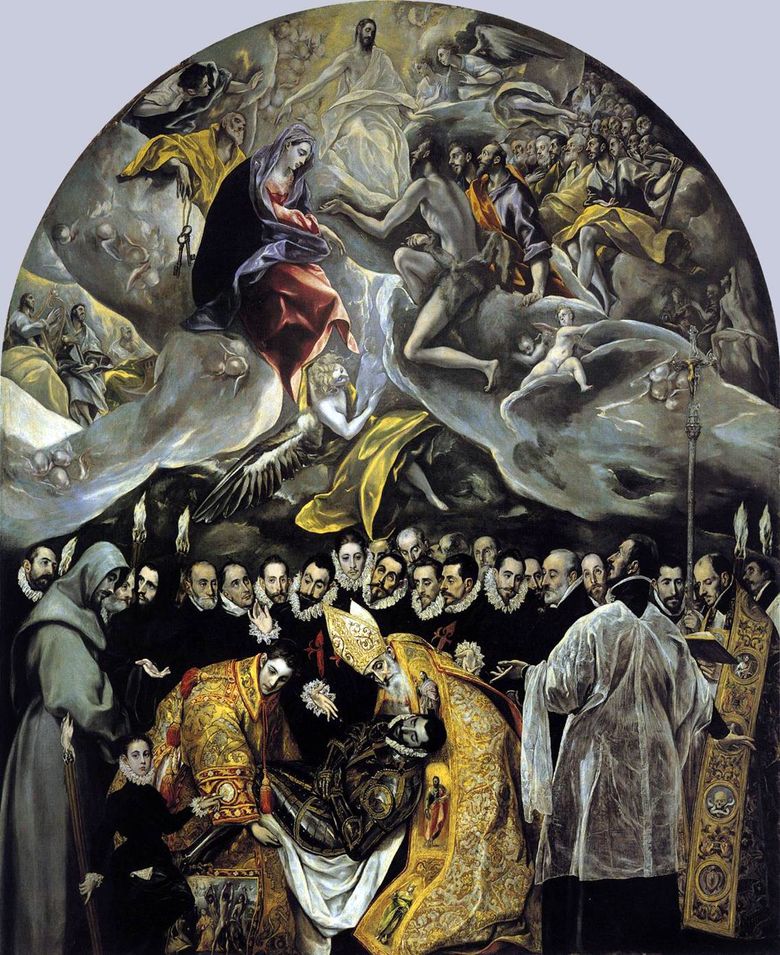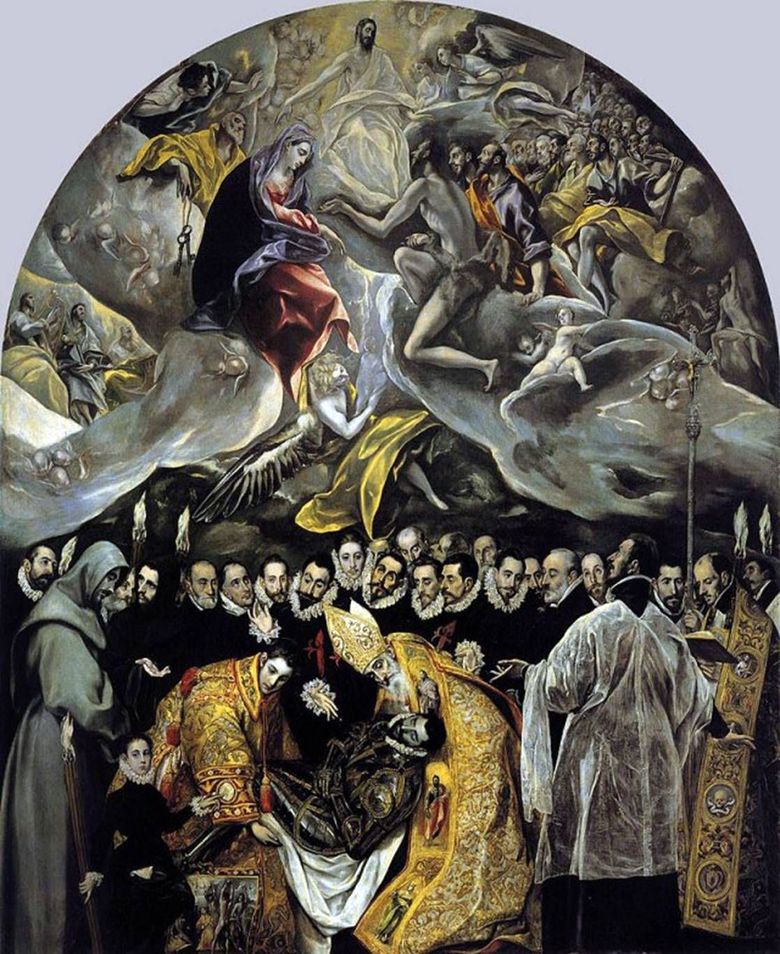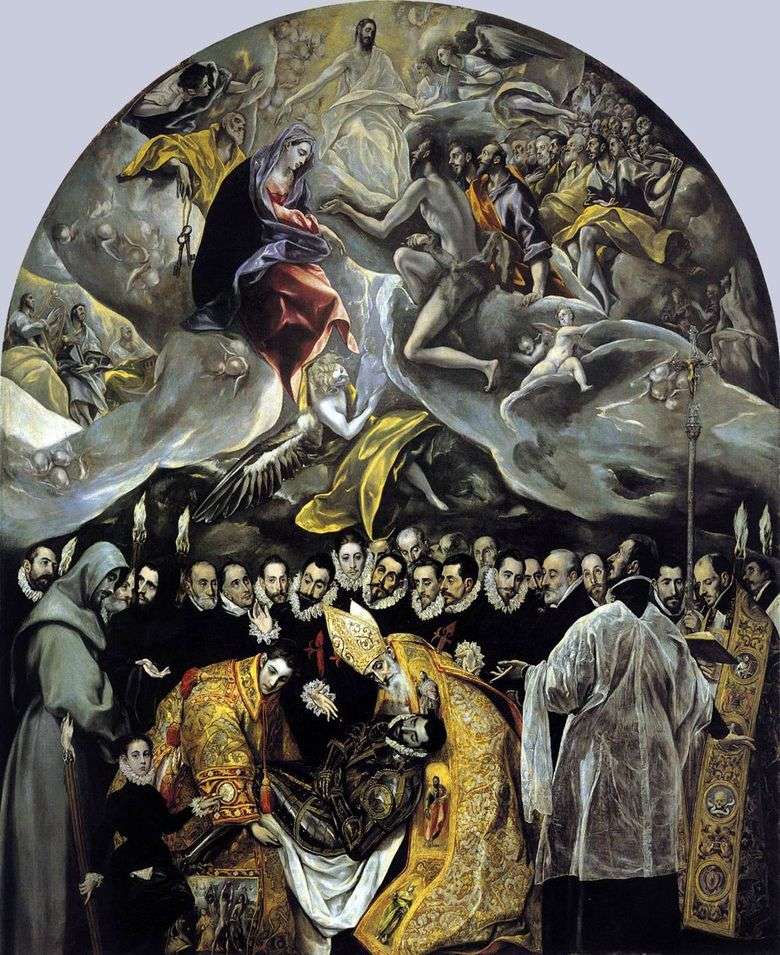
Painting of the Spanish painter El Greco “The Burial of Count Orgas”. The size of the picture is 480 x 360 cm, canvas, oil. The glory of El Greco in Spain reached its peak after the creation for the modest parish church of Santa Tome of the magnificent painting “The Burial of Count Orgas” on the plot of an old legend.
Most of the artist’s paintings, written on the subjects of the New Testament, have a well-known uniformity of artistic decisions. Greco often returned to the same images. Among the works of this kind stands out his famous painting “The Burial of Count Orgas.” At the heart of her plot is the medieval legend of the wonderful burial of the pious Count Orgas by St. Augustine and Stephen. The solemn-mournful scene of the funeral ceremony is placed in the lower part of the picture. At the top, heaven opens, and Christ at the head of a host of saints accepts the soul of the deceased. And here the mystical miracle is the main content of the picture. However, her imaginative solution is much more complex and deeper than in other works of the master.
In this canvas, in harmonic unity, there are, as it were, three plans for representing the artist about the world. His purely visionary perception is embodied in the upper, heavenly zone. At the same time, the image of the participants in the funeral mass – monks, clergy and especially the Toledan nobility, in the images of which El Greco created excellent portraits of his contemporaries, brings to the picture a sense of reality. But these real participants in the burial of Count Orgas are involved in the miracle. Their spiritual experiences with amazing refinement are embodied in thin pale faces, in restrained gestures of fragile hands – as if bursts of inner feelings.
Finally, a kind of synthesis of the concrete-real and abstract-sublime bear in themselves the images of St. Augustine and Stephen, who in the foreground gently support the body of the deceased. Nowhere at El Greco sorrow, deep tenderness and sorrow were not expressed with such humanity. And at the same time, images of saints are the very embodiment of the highest spiritual beauty.
The appeal of the painter El Greco to the theme of life and death, to the direct transfer of the world of human feelings and their ideal transformation gives the picture an exceptional content and multi-tone. A complex comparison of the various imaginative plans is manifested even in particulars. Thus, the brocade of St. Stephen is decorated with images of episodes from his life – the stoning of a saint. This is not just elegant embroidery, but a whole picture typical of El Greco’s ghostly nature. The introduction of such a motive, as it were, combines the present and the past in the depiction of a beautiful youth, gives its image a multifaceted hue. And in the coloristic sound of the picture, written in a magnificent solemn-mourning scale with accents of white-silver, yellow, dark blue and red tones, various picturesque solutions are merged.
The conditional unreal coloring of the celestial sphere, where the transparent clouds are illuminated by the inner light, are opposed by the more powerful, dark, gray-black tones of the lower zone in the clothes of noblemen, monastic cassocks, in the glittering metallic lashes of Orgas. A peculiar combination of these opposing trends are the figures of St. Augustine and Stephen. Keeping the measure of reality, bright on a dark background, the spots of their heavy gold-plated rhizomes at the same time are fantastically shimmering in the radiance of the pinkish-red light of funeral torches.
 The funeral of Count Orgas by El Greco
The funeral of Count Orgas by El Greco Les funérailles du comte Orgas – El Greco
Les funérailles du comte Orgas – El Greco Annunciation by El Greco
Annunciation by El Greco Self-portrait by El Greco
Self-portrait by El Greco Enterrement du comte Orgas – El Greco
Enterrement du comte Orgas – El Greco The Position of Christ in the Coffin by El Greco
The Position of Christ in the Coffin by El Greco The Holy Apostle Andrew by El Greco
The Holy Apostle Andrew by El Greco Funeral del Conde Orgaz – El Greco
Funeral del Conde Orgaz – El Greco